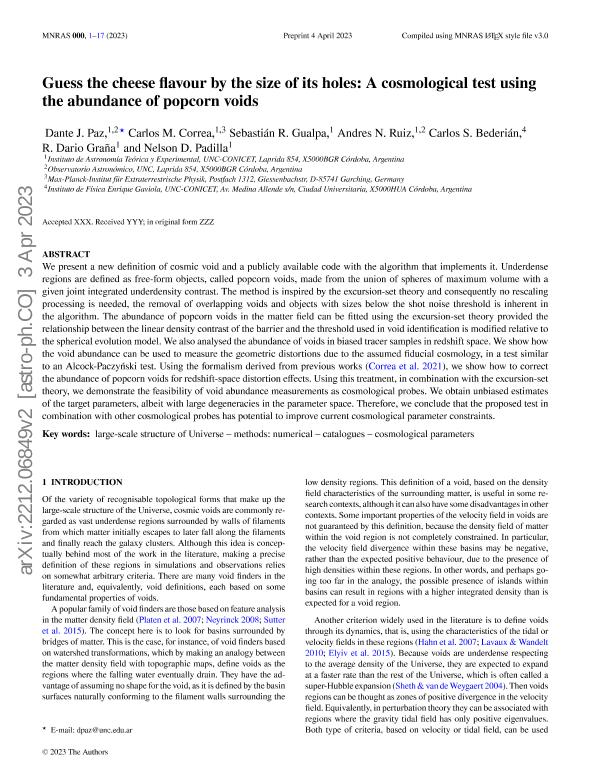Mostrar el registro sencillo del ítem
dc.contributor.author
Paz, Dante Javier

dc.contributor.author
Correa, Carlos Mauricio

dc.contributor.author
Gualpa, Sebastián Rogelio

dc.contributor.author
Ruiz, Andrés Nicolás

dc.contributor.author
Bederian, Carlos Sergio

dc.contributor.author
Graña, Ruben Dario

dc.contributor.author
Padilla, Nelson David

dc.date.available
2024-02-08T14:48:10Z
dc.date.issued
2023-06
dc.identifier.citation
Paz, Dante Javier; Correa, Carlos Mauricio; Gualpa, Sebastián Rogelio; Ruiz, Andrés Nicolás; Bederian, Carlos Sergio; et al.; Guess the cheese flavour by the size of its holes: a cosmological test using the abundance of popcorn voids; Wiley Blackwell Publishing, Inc; Monthly Notices of the Royal Astronomical Society; 522; 2; 6-2023; 2553-2569
dc.identifier.issn
0035-8711
dc.identifier.uri
http://hdl.handle.net/11336/226465
dc.description.abstract
We present a new definition of cosmic void and a publicly available code with the algorithm that implements it. Underdense regions are defined as free-form objects, called popcorn voids, made from the union of spheres of maximum volume with a given joint integrated underdensity contrast. The method is inspired by the excursion-set theory and consequently no rescaling processing is needed, the removal of overlapping voids and objects with sizes below the shot noise threshold is inherent in the algorithm. The abundance of popcorn voids in the matter field can be fitted using the excursion-set theory provided the relationship between the linear density contrast of the barrier and the threshold used in void identification is modified relative to the spherical evolution model. We also analysed the abundance of voids in biased tracer samples in redshift space. We show how the void abundance can be used to measure the geometric distortions due to the assumed fiducial cosmology, in a test similar to an Alcock–Paczyński test. Using the formalism derived from previous works, we show how to correct the abundance of popcorn voids for redshift-space distortion effects. Using this treatment, in combination with the excursion-set theory, we demonstrate the feasibility of void abundance measurements as cosmological probes. We obtain unbiased estimates of the target parameters, albeit with large degeneracies in the parameter space. Therefore, we conclude that the proposed test in combination with other cosmological probes has potential to improve current cosmological parameter constraints.
dc.format
application/pdf
dc.language.iso
eng
dc.publisher
Wiley Blackwell Publishing, Inc

dc.rights
info:eu-repo/semantics/openAccess
dc.rights.uri
https://creativecommons.org/licenses/by-nc-sa/2.5/ar/
dc.subject
CATALOGUES
dc.subject
COSMOLOGICAL PARAMETERS
dc.subject
LARGE-SCALE STRUCTURE OF UNIVERSE
dc.subject
METHODS: NUMERICAL
dc.subject.classification
Astronomía

dc.subject.classification
Ciencias Físicas

dc.subject.classification
CIENCIAS NATURALES Y EXACTAS

dc.title
Guess the cheese flavour by the size of its holes: a cosmological test using the abundance of popcorn voids
dc.type
info:eu-repo/semantics/article
dc.type
info:ar-repo/semantics/artículo
dc.type
info:eu-repo/semantics/publishedVersion
dc.date.updated
2024-02-08T10:34:48Z
dc.journal.volume
522
dc.journal.number
2
dc.journal.pagination
2553-2569
dc.journal.pais
Reino Unido

dc.journal.ciudad
Londres
dc.description.fil
Fil: Paz, Dante Javier. Consejo Nacional de Investigaciones Científicas y Técnicas. Centro Científico Tecnológico Conicet - Córdoba. Instituto de Astronomía Teórica y Experimental. Universidad Nacional de Córdoba. Observatorio Astronómico de Córdoba. Instituto de Astronomía Teórica y Experimental; Argentina
dc.description.fil
Fil: Correa, Carlos Mauricio. Universidad Nacional de Córdoba. Observatorio Astronómico de Córdoba; Argentina. Consejo Nacional de Investigaciones Científicas y Técnicas. Centro Científico Tecnológico Conicet - Córdoba. Instituto de Astronomía Teórica y Experimental. Universidad Nacional de Córdoba. Observatorio Astronómico de Córdoba. Instituto de Astronomía Teórica y Experimental; Argentina
dc.description.fil
Fil: Gualpa, Sebastián Rogelio. Consejo Nacional de Investigaciones Científicas y Técnicas. Centro Científico Tecnológico Conicet - Córdoba. Instituto de Astronomía Teórica y Experimental. Universidad Nacional de Córdoba. Observatorio Astronómico de Córdoba. Instituto de Astronomía Teórica y Experimental; Argentina
dc.description.fil
Fil: Ruiz, Andrés Nicolás. Consejo Nacional de Investigaciones Científicas y Técnicas. Centro Científico Tecnológico Conicet - Córdoba. Instituto de Astronomía Teórica y Experimental. Universidad Nacional de Córdoba. Observatorio Astronómico de Córdoba. Instituto de Astronomía Teórica y Experimental; Argentina
dc.description.fil
Fil: Bederian, Carlos Sergio. Consejo Nacional de Investigaciones Científicas y Técnicas. Centro Científico Tecnológico Conicet - Córdoba. Instituto de Física Enrique Gaviola. Universidad Nacional de Córdoba. Instituto de Física Enrique Gaviola; Argentina
dc.description.fil
Fil: Graña, Ruben Dario. Consejo Nacional de Investigaciones Científicas y Técnicas. Centro Científico Tecnológico Conicet - Córdoba. Instituto de Astronomía Teórica y Experimental. Universidad Nacional de Córdoba. Observatorio Astronómico de Córdoba. Instituto de Astronomía Teórica y Experimental; Argentina
dc.description.fil
Fil: Padilla, Nelson David. Consejo Nacional de Investigaciones Científicas y Técnicas. Centro Científico Tecnológico Conicet - Córdoba. Instituto de Astronomía Teórica y Experimental. Universidad Nacional de Córdoba. Observatorio Astronómico de Córdoba. Instituto de Astronomía Teórica y Experimental; Argentina
dc.journal.title
Monthly Notices of the Royal Astronomical Society

dc.relation.alternativeid
info:eu-repo/semantics/altIdentifier/url/https://academic.oup.com/mnras/article/522/2/2553/7129031
dc.relation.alternativeid
info:eu-repo/semantics/altIdentifier/doi/http://dx.doi.org/10.1093/mnras/stad1146
Archivos asociados
